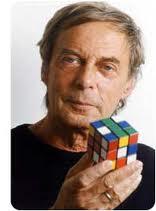
Ernő Rubik (known in his native Hungary as "Rubik Ernő" — Hungarian custom is surname-first) was born in Budapest, Hungary during World War II. His mother was a poet, his father an aircraft engineer who started a company to build gliders.
Rubik's initial attraction to inventing the Rubik's Cube was not in producing the best selling toy puzzle in history. The structural design problem interested Rubik; he asked, "How could the blocks move independently without falling apart?" In Rubik's Cube, 26 individual little cubes or cubies make up the big Cube. Each layer of nine cubies can twist and the layers can overlap. Any three squares in a row, except diagonally, can join a new layer. Rubik's initial attempt to use elastic bands failed, his solution was to have the blocks hold themselves together by their shape. Rubik hand carved and assembled the little cubies together. He marked each side of the big Cube with adhesive paper of a different color, and started twisting.
"It was wonderful, to see how, after only a few turns, the colors became mixed, apparently in random fashion. It was tremendously satisfying to watch this color parade. Like after a nice walk when you have seen many lovely sights you decide to go home, after a while I decided it was time to go home, let us put the cubes back in order. And it was at that moment that I came face to face with the Big Challenge: What is the way home?" — Ernő Rubik That was how the Cube as a puzzle, was invented in the spring of 1974, when the twenty-nine year old Rubik discovered it was not so easy to realign the colors to match on all 6 sides. He was not sure he would ever be able to return his invention to its original position. He theorized that by randomly twisting the Cube he would never be able to fix it in a lifetime, which later turned out to be more than correct. He began working out a solution, starting with aligning the eight corner cubies. He discovered certain sequences of moves for rearranging just a few cubies at a time. Within a month, he had the puzzle solved and an amazing journey lay ahead...
Rubik applied for his Hungarian patent in January 1975 and left his invention with a small toy making cooperative in Budapest. The patent approval finally came in early 1977 and the first Cubes appeared at the end of 1977. By this time, Ernő Rubik was married. Two other people applied for similar patents at about the same time as Rubik. Terutoshi Ishige applied a year after Rubik, for a Japanese patent on a very similar cube. An American, Larry Nichols, patented a cube before Rubik, held together with magnets. Nichols' toy was rejected by all toy companies, including the Ideal Toy Corporation, which later bought the rights to Rubik's Cube.
Sales of the Rubik's Cube were sluggish until Hungarian businessman Tibor Laczi discovered the Cube. While having a coffee, he spied a waiter playing with the toy. Laczi, an amateur mathematician, was impressed. The next day he went to the state trading company, Konsumex, and asked permission to sell the Cube in the West.
"When Rubik first walked into the room I felt like giving him some money," he says. "He looked like a beggar. He was terribly dressed, and he had a cheap Hungarian cigarette hanging out of his mouth. But I knew I had a genius on my hands. I told him we could sell millions." — Tibor Laczi on meeting Ernő Rubik.
Laczi proceeded to demonstrate the Cube at the Nuremberg toy fair, but not as an official exhibitor. Laczi walked around the fair playing with a Cube and managed to meet British toy expert Tom Kremer. Kremer thought Rubik's Cube was the wonder of the world. He later arranged an order for a million Cubes with Ideal Toy.
Rubik's Cube was first called the Magic Cube (Bűvös Kocka) in Hungary. The puzzle had not been patented internationally within a year of the original patent. Patent law then prevented the possibility of an international patent. Ideal Toy wanted at least a recognizable name to copyright; of course, that arrangement put Rubik in the spotlight because the Magic Cube was renamed after its inventor.
Ernő Rubik became the first self-made millionaire from the communist bloc. The eighties and Rubik's Cube went well together. Cubic Rubes or Cubists (the name of cube fans) formed clubs to play and study solutions. A 16-year-old Vietnamese high school student from Los Angeles, Minh Thai won the world championship in Budapest (June 1982) by unscrambling a Cube in 22.95 seconds. The unofficial speed records may be ten seconds or less. Human experts now solve the puzzle in 24-28 moves on a regular basis.
Ernő Rubik has established a foundation to help promising inventors in Hungary. He also runs the Rubik Studio, which employs a dozen people to design furniture and toys. Rubik has produced several other toys, including Rubik's Snake. He has plans to start designing computer games and continues to develop his theories on geometric structures. Seven Towns Ltd. currently holds the rights to Rubik's Cube.
One of Ernő's quotes is "A good puzzle, it's a fair thing. Nobody is lying. It's very clear, and the problem depends just on you."